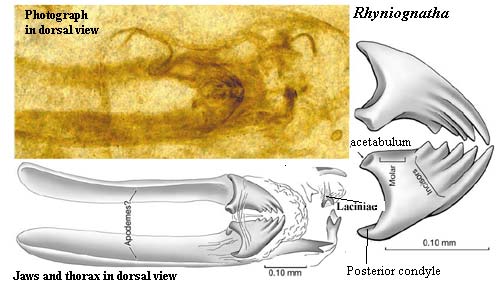Pterygota: Paleoptera
Taxa on This Page
- Rhyniognatha
Introduction
 Classically, the Paleoptera have been defined both apomorphically and paraphyletically..... That's a mouthful. Perhaps we should try again. Paleoptera are usually defined as "primitive winged insects." So, all paleopterans, and no other arthropods, are supposed to have a particular physical characteristic (wings) in common. That's the "apomorphic" part. However, the Paleoptera don't include all winged insects -- just the "primitive" ones. That's the "paraphyletic" part. This sort of definition is hopelessly vague and invites problems of classification.
Classically, the Paleoptera have been defined both apomorphically and paraphyletically..... That's a mouthful. Perhaps we should try again. Paleoptera are usually defined as "primitive winged insects." So, all paleopterans, and no other arthropods, are supposed to have a particular physical characteristic (wings) in common. That's the "apomorphic" part. However, the Paleoptera don't include all winged insects -- just the "primitive" ones. That's the "paraphyletic" part. This sort of definition is hopelessly vague and invites problems of classification.
Those problems recently surfaced in this group with the discovery -- actually, the redescription -- of Rhyniognatha, an insect from the Pragian Early Devonian) of Scotland. Engel & Grimaldi (2004). Rhyniognatha is like other Paleoptera in most respects, but it probably had no wings. On the other hand, it is not a silverfish (Thysanura). The mouth parts are all wrong for a silverfish. The mouth parts are entirely correct for a paleopteran -- but there are no wings and no reason to believe there ever were any wings.
The reaction to Rhyniognatha in the semi-scientific press has been interesting. It was speculated by Engel & Grimaldi that Rhyniognatha's early Devonian date might imply that insects began even earlier, in the Silurian. The press duly reported that Rhyniognatha was Silurian. Much more importantly, Engel & Grimaldi stated, quite correctly, that Rhyniognatha appeared to be a paleopteran. It was duly reported that flying insects were present in the Silurian ... .
In fact, there are no flying insects known for almost a hundred million years after the Ludlow Late Silurian). Flying insects are first found in the Carboniferous, specifically, the Late Mississippian. The acquisition of flight in insects was followed -- just as in pterosaurs, birds, and bats -- by an explosive radiation of flying forms and non-flying taxa related to them. So, were the press out of line? Maybe, but the real problem is that silly definition: "primitive winged insects." It invites precisely the misunderstandings which followed the article by Engel & Grimaldi. The irony is that the Paleoptera are some of the very insects studied by Willi Hennig, the founder of cladistics, whose influence on evolutionary theory is exceeded only by Darwin. Here, if anywhere, we would expect to see the hand of the cladistic Reformation which Hennig began.
But we don't. However, in homage to Hennig, we will ignore traditional usage and give Paleoptera a proper phylogenetic definition: fire ants (Solenopsis) > fire brats (Thermobia). For an explanation of this terminology, see Dendrograms. This makes Rhyniognatha a paleopteran because, very probably, it shares a more recent common ancestor with Solenopsis than with Thermobia -- whether or not Rhyniognatha had wings.
ATW041020. Text public domain. No rights reserved.
Paleopteran Relationships and Diversity
Paleopteran relationships are a contentious field. [1] Fortunately there are relatively few who care enough to contend, so collateral damage to civilians has been slight. Our own take on the subject is summarized in the following cladogram:
Hennig himself favored a monophyletic Paleoptera. In this scheme, Paleoptera and Neoptera represent a fundamental divergence between two designs for flight, which diverged long ago, something like this:
Unfortunately, our principled defense of Hennigian historic primacy in the previous section has pretty much exhausted our meager supply of principle. Thus we unctuously defer to current orthodoxy and treat the relationship as paraphyletic.
The main groups of paleopterans are all treated on separate pages, with the exception of the Megasecoptera, which we now summarize in the following fashion.
ATW041022. Text and Protohymen image public domain. No rights reserved.
Notes
[1]While the relationships of the extinct paleodictyopteroid orders (Diaphanopterodea, Palaeodictyoptera, Megasecoptera, and Permothemistida) to each other and to other orders have not been extensively examined, the relationships of the three living lineages (Ephemeroptera, Odonata, and Neoptera) to each other have been the subject of much debate. Each of the three possible relationships are supported by various authors.
A monophyletic Paleoptera was advocated by Hennig (1981) and Hovmöller et al. (2002):
Insecta
├─Paleoptera
│ ├─Odonata
│ └─Ephemeroptera
└─Neoptera
Boudreaux (1979) favored monophyly of Ephemeroptera + Neoptera:
Insecta
├─Odonata
└─┬─Ephemeroptera
└─Neoptera
Kristensen (1975, 1991) Wheeler et al. (2001) and Grimaldi & Engel (2005) present evidence in support of monophyly of Odonata + Neoptera:
Insecta
├─Ephemeroptera
└─┬─Odonata
└─Neoptera
David R. Maddison, ToL CC-BY 2002
Descriptions
Rhyniognatha
Phylogeny: Pterygota : (Ephemeroptera + Palaeodictyopteroida + Odonatoptera + Neoptera) + *
Comments: Ancestral/basal pterygotan. See main essay
checked ATW060202, revised MAK120516;
 Classically, the Paleoptera have been defined both apomorphically and paraphyletically..... That's a mouthful. Perhaps we should try again. Paleoptera are usually defined as "primitive winged insects." So, all paleopterans, and no other arthropods, are supposed to have a particular physical characteristic (wings) in common. That's the "apomorphic" part. However, the Paleoptera don't include all winged insects -- just the "primitive" ones. That's the "paraphyletic" part. This sort of definition is hopelessly vague and invites problems of classification.
Classically, the Paleoptera have been defined both apomorphically and paraphyletically..... That's a mouthful. Perhaps we should try again. Paleoptera are usually defined as "primitive winged insects." So, all paleopterans, and no other arthropods, are supposed to have a particular physical characteristic (wings) in common. That's the "apomorphic" part. However, the Paleoptera don't include all winged insects -- just the "primitive" ones. That's the "paraphyletic" part. This sort of definition is hopelessly vague and invites problems of classification.
